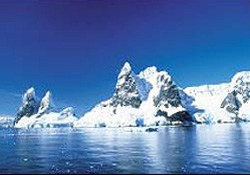Ice melted massively, 100 years from now, will the Arctic still have ice?
On the occasion of the International Conference on Climate in Monreal (Canada), Arctic is the most impacted area of global warming. It is predicted that within 100 years, with this momentum, the entire glacier here will melt in the summer.
 The Arctic without ice is a seemingly surreal idea but that can happen due to global warming. This phenomenon has the most significant impact on polar regions, where the rate of increase in temperature is twice as fast as elsewhere on Earth.
The Arctic without ice is a seemingly surreal idea but that can happen due to global warming. This phenomenon has the most significant impact on polar regions, where the rate of increase in temperature is twice as fast as elsewhere on Earth.
Satellite images from 1979 to the present show that glaciers have decreased by more than 20% in the summer. Recent studies predict that by around 2070, glaciers will disappear completely when summer comes. Farther south, Greenland residents began to feel the effects of global warming. The snow falls more and more slowly and dissolves sooner. Habits of humans and animals are disturbed.
Latest observations suggest that more and more Greenland coastal areas affected by irreversible melting of glaciers may have serious consequences for sea level. The amount of water contained in Greenland is equivalent to a 6-meter-high water layer spread across the oceans.
Rising sea level is a phenomenon related to the melting of the continent's ice, not the melting of the glacier. When the ice cubes are dissolved in a glass, the water level in them does not rise. That is the phenomenon of glacial ice floating in the ocean. But when the stone is placed on the surface of the water and melts, like the ice of the continent, the water formed will overflow the glass.
One thing is for sure, mass ice melting has begun and may last for hundreds of years. If people want to limit their impact, they must change their habits from now on.
- Arctic will melt ice after 5 years
- The Arctic lost three times as much ice as Belgium every day
- Ice in the Arctic is likely to disappear by 2030
- Ice melts, the sea is wide and the Arctic is in danger
- The Arctic ice melted four times faster than forecast
- The Arctic melted, making the winter colder
- The Arctic temperature is the highest in 44,000 years
- Greenland ice suddenly melted massively
- The Arctic Sea is the hottest 2,000 years
- Walrus migrated massively from the North Pole to the United States
- In 40 years the Arctic will run out of ice?
- Interesting facts about animals living in the Arctic
 Is the magnetic North Pole shift dangerous to humanity?
Is the magnetic North Pole shift dangerous to humanity? Washington legalizes the recycling of human bodies into fertilizer
Washington legalizes the recycling of human bodies into fertilizer Lightning stone - the mysterious guest
Lightning stone - the mysterious guest Stunned by the mysterious sunset, strange appearance
Stunned by the mysterious sunset, strange appearance